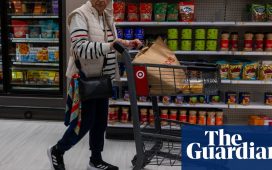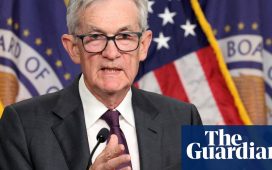Strolling past the colorfully restored Victorian homes of the Fourth Ward, watching the barman hand-carve blocks of ice for old-fashioneds at the jam-packed bar of the Crunkleton, it’s easy to fall for Charlotte’s ample southern charms. And yet, people are not happy – at least according to the polls.
Consumer sentiment in North Carolina is now lower than it was at the height of the pandemic, according to High Point University’s confidence tracker. “People are just not feeling particularly good,” said Martin Kifer, director of the university’s survey research center.
North Carolina is not alone. Official figures suggest the US pulled off an astonishing recovery from the Covid pandemic and recession.
More than 20 million people in the US lost their jobs in April 2020 as the coronavirus pandemic shuttered the world’s largest economy. The unemployment rate rose to 14.7%. But the rebound was just as dramatic. Unemployment has hovered near 50-year lows since January 2022 and is now 3.8%. In North Carolina, it’s just 3.3%. More than 100 people are moving to the city every day.
But as an exclusive Guardian/Harris Poll survey found this week, two-thirds (68%) of Americans report it’s difficult to be happy about positive economic news when they feel financially squeezed each month.
Across the country, poll after poll shows people are not feeling it. That’s not good news for the Biden administration, particularly in a potential swing state where the perceived success – or failure – of “Bidenomics”, as Biden has dubbed his economic strategy, will be one of the key issues in next year’s election.

The election is still a way out, and Biden has proven pollsters wrong in the past. Nevertheless, the economy – or voters’ perception of it – will be a defining issue in one of the most consequential elections in US history.
Americans are deeply divided on the economy. The Harris Poll shows over half (53%) of Americans believe the economy is getting worse. Some 72% of Republicans share that view compared with 32% of Democrats. But the unhappiness runs deep on both sides. Only a third of Democrats believe that the economy is getting better.
Even when Americans say they are doing OK financially, they believe the economy is in trouble. According to the Federal Reserve’s annual survey of economic wellbeing, 73% of households said that they were “at least doing OK financially” at the end of 2022. In 2019, that figure was 75% of households. But back then, 50% said the national economy was good or excellent. By 2022, that number had fallen to just 18%.
Some heavyweight voices share the gloom. Both the former treasury secretary Larry Summers and Bill Dudley, former president of the Federal Reserve Bank of New York, have speculated that having shot out of the pandemic like a coyote chasing a roadrunner, the US may be in a “Wile E Coyote” economy and, like Warner Bros’ cartoon canine, the US economy may be heading off a cliff. “Falling back to earth will not be a pleasant experience,” Dudley has warned.
Partisanship explains much of the seeming disconnect between economic data and sentiment. But not all of it. Large forces are reshaping the US economy and may explain the nation’s vertigo.
Many low-wage workers have been living with that fear of falling for a long time.
Ieisha Franceis’s wages have shot up from $12.50 to $17 since the Durham, North Carolina, resident made the shift from working in fast food to a job at a senior living facility. Wages are – finally – running ahead of inflation overall, but for Franceis, “everything looks the same. Inflation’s not gone down, it’s just not going up,” she said. “These days $17 an hour is looking a lot like $12.50,” said the low-wage activist.
Franceis used to buy her family’s side dishes – boxes of macaroni and cheese and mashed potatoes – at Dollar General. The Kraft macaroni and cheese (“the good stuff”) has gone. “Now they only carry a cheaper brand with the powdered cheese.” At the average grocery store, that Kraft Mac & Cheese is more than $2.
“The Dollar Tree went from everything being $1 to everything being $1.25. Now they even have a $5 section and a $10 section. Huh? This was a dollar store,” she said. “Bidenomics” means little to Franceis. “What we need is higher wages and more unions,” she said.

Even entrepreneurs are finding the new, post-Covid economy taxing.
Cocktail queen Tamu Curtis saw her business boom during lockdown. A Los Angeles transplant, she started giving cocktail classes online and saved enough to open her bricks-and-mortar shop. The Cocktailery – nestled between an Anthropologie and a Warby Parker inside an old streetcar station – opened in September 2021 when the vaccines started rolling out. “I thought, ‘OK, everybody is going to run and get the vaccines. We are saved!’ Of course, it didn’t work out that way,” she said ruefully. “That was a plot twist.”
Up and running now for over a year, business has been strange. “This has been the craziest summer. It’s so slow,” she said.
Retail sales have collapsed but classes have boomed. “People will spend money on experiences. On travel. We spent two years filling our houses with stuff. Maybe we just don’t need that any more.”
On top of that, she said, “inflation is killing me.” An order of cocktail bitters that used to cost her $700 shot up to $1,500. “There’s only so much you can pass on. I can’t sell a bitter for $42. There’s a max people will pay.”
At the same time, rent is high and financing is getting tougher as interest rates rise. “It’s difficult,” she said. And more so for a minority, woman-owned business. She hasn’t been able to get a traditional bank loan yet or a line of credit from her bank, Charlotte-based Bank of America. “Now the banks aren’t lending the way they were.”

Post-Covid has been an easier ride for other local business people but still, existential questions remain, ones that may point to a wider national malaise.
Desmond Wiggan and his partner Aubrey Yeboah launched their business, BatteryXchange, in 2019, just before the pandemic. The company sets up battery-charging stations for mobile devices, and the idea had originally been to target people at conferences or out on the town. “Suddenly there were no people,” said Wiggan.
BatteryXchange retooled and now rents its equipment to healthcare providers and others who use the service to help keep their customers online. It worked and business is booming, as is Wiggan’s profile. He has just returned from a business symposium on swanky Martha’s Vineyard. A copy of Propel, a local Black business magazine, sits on his office table. Wiggan’s headshot is above a message from Michelle Obama: “Success isn’t about how much money you make, it’s about the difference you make.”
But Wiggan has some wider concerns. He spent two years living in China and has seen first-hand that other countries think on a longer timescale. Back in the US, he said, it’s all about the next election cycle. On top of that, another likely hot election issue worries him. “The age gap of our leaders. They are old. The torch has got to be passed.
“These other countries are starting to sniff us out,” he said. Foreign students were getting their education in the US then going home because they see their country looking to the future, he said. “They are thinking 2060, not every four, eight years when we go back and forth.”
Why people feel so bad about an economy that – technically – appears strong is a question that is vexing not just the White House but Nobel economic laureates. Historians will have a better answer. For now, the reasons look manifold.
As High Point University’s Kifer points out, “the perception of the economy is not the economy.” The disconnect between the official figures and how people feel may be temporary. Nor is it unusual for the hangover of a recession to outlast what looks like the beginning of a recovery. High Point’s own consumer confidence index started in 2010, two years after the peak of the 2008/2009 recession. It wasn’t until September 2011 that confidence started rising.

The US’s pandemic recession began in February 2020 and ended two months later, making it the shortest recession on record. The body blow it dealt to confidence is, however, proving hard to shift. And things are different this time. For one, there is relatively high inflation – something never directly experienced by Americans under 40. Slowing increases have done little to calm people’s nerves and most people in North Carolina expect inflation to get worse next year, according to another HPU poll.
The mood of economic despondency is fueled by other fires, too, illustrated by life in North Carolina and felt across the country.
Politics plays a huge role. The University of Michigan’s national consumer confidence index shows Republican confidence soared under Trump and dropped under Biden while Democrats’ did the opposite.
But it’s not the only factor. While people may not have lost their jobs, America’s middle class has lost $2tn in wealth since 2020 thanks to inflation and the fastest increase in interest rates since the 1980s, according to data compiled by economists at the University of California, Berkeley.
That fall comes after outsized gains from stimulus cheques, rising house prices and other assets for those who rode out the pandemic with little financial cost. Still, the psychological pain of losing is about twice the pleasure of winning, according to Nobel-winning psychologist and economist Daniel Kahneman. Losses loom larger than gains.
Then there are the epochal issues of our day – ones that will spread far beyond North Carolina and the Biden presidency.
North Carolina has been voted the best state for business for two consecutive years and business is still good. But there are signs of a slowdown. According to the Charlotte Regional Business Alliance, the Charlotte area expects businesses to invest $2.3bn in the region this year and create 7,200 jobs. That’s down from $8bn in investment and 20,000 jobs last year.
Uncertainty is a large part of that drop, said Danny Chavez, chief business recruitment officer of the Charlotte Regional Business Alliance. Concerns about the direction of interest rates and political change are part of it – businesses are waiting to see what happens next year, a natural part of the cycle. There is also something more.
The number of jobs created per investment is also decreasing as tech takes jobs. Financial services and manufacturing are extremely important to the region. They remain so, said Chavez. “But in terms of jobs, both those industries are highly vulnerable to automation and AI,” he said.

While Charlotte is better positioned than most to ride out that change, Chavez said the region – and the rest of the US – is also increasingly competing with global players. India and China are challenging the US’s rank as the world’s largest economy.
Biden’s economic plans are playing to the long term and the US has proved resilient to big shocks before. The president also has a track record of beating expectations. If hiring stays steady and inflation keeps receding, maybe Americans will hear the good news soon. That may or may not happen before the 2024 election.
But the polls may also reflect a wider anxiety about the existential challenges the US (and other economies) face. Perhaps those challenges explain some of the national mood. It’s hard to measure existential dread.
Longer term, neither Bidenomics nor Trumponomics is likely to fix America’s broken healthcare and childcare systems or the climate crisis. Nor do they offer clear solutions to the global trade winds that threaten American exceptionalism or the challenges presented by AI and automation.
Little wonder then that so many in the US feel like Wile E Coyote, running off the cliff, treading air, waiting for the fall.







